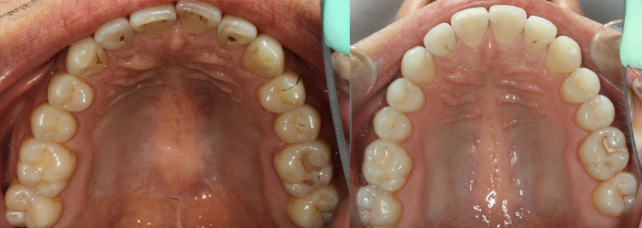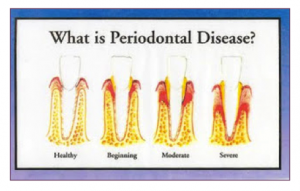Why Does Water Hurt My Teeth? Tooth Sensitivity to Water
February 16th, 2017

Have you ever taken a sip of water and felt a sharp pain in your teeth? This likely means that you have sensitive teeth, and that doing something simple, such as drinking a glass of water, or taking a deep breath through your mouth, can be painful.
So what causes this and how can you fix it?
Tooth Sensitivity
Tooth sensitivity occurs when the protective enamel on our teeth gets thinner, or when our gums recede. There are many reasons why this could be happening:
- You might be brushing your teeth too hard. When you put too much pressure on your teeth while brushing, you can gradually start wearing down the protective layers of your teeth. When this occurs, the tubes or canals that lead to your nerves may become exposed, which can lead to pain or discomfort, especially when eating or drinking something hot or cold. Try using lighter strokes when brushing.
- You could have cavities or loose fillings. Cavities are holes in your teeth that can grow bigger over time. The bigger the hole gets, the more sensitive your teeth can feel. If you think you might have a cavity, or one of your fillings may be loose, make sure to see your dentist right away.
- You’re grinding your teeth. Grinding your teeth can wear down the protective enamel on your teeth, but many people may not even realize that they’re doing it. Oftentimes, people grind their teeth in their sleep.
- You could have a cracked or broken tooth. A cracked or broken tooth can expose the tooth’s nerve, which can cause sensitivity or pain.
- You may have gum disease. Gum disease is caused by plaque, the sticky bacteria that constantly forms on our teeth. If that plaque is not removed with brushing and flossing, it may harden and form “tartar,” which is then very difficult to remove. Teeth sensitivity can be a symptom of gum disease.
- Your mouthwash or toothpaste could be causing it. Some teeth-whitening toothpastes and mouthwashes contain chemicals that your teeth may become sensitive to. Try switching to a mouthwash with less chemicals and a desensitizing toothpaste, such as Sensodyne.
- The foods you’re eating might be too acidic. Excessive consumption of acidic foods or beverages can put your teeth at risk for tooth sensitivity.
Treatments For Sensitive Teeth
If you’re experiencing pain associated with sensitive teeth, there are a number of treatments a dentist can perform that may help, depending on the cause.
- Desensitizing with Gluma is a dental treatment that can help your teeth become less sensitive by stopping by occluding (blocking) the microscopic tubules that compose dentin, thereby preventing the flow of fluid and decreasing sensitivity.
- Gum Disease Treatment Therapy can help treat gum disease, a major contributor of teeth sensitivity, with targeted treatments designed just for you.
- A crown, inlay or bonding can fix a broken tooth or decay that might be causing your teeth to be sensitive. Water Tower Dental Care is proud to offer porcelain crowns in just one visit with CEREC technology.
If you are experiencing tooth sensitivity or have any questions about it, please contact Water Tower Dental Care today.

 Hydrogen peroxide is a medicine cabinet staple. Used for cleaning up scrapes and cuts, it also offers directions for oral use right on the label. But can it be harmful to your teeth?
Hydrogen peroxide is a medicine cabinet staple. Used for cleaning up scrapes and cuts, it also offers directions for oral use right on the label. But can it be harmful to your teeth?  Flossing is one of the more overlooked (and frequently skipped) steps to good dental hygiene. Dentists agree it’s an essential part of dental care. But if it seems like your floss is getting stuck between your teeth more often than your food does, it’s tempting just to brush your teeth and skip flossing. Don’t do it!
Flossing is one of the more overlooked (and frequently skipped) steps to good dental hygiene. Dentists agree it’s an essential part of dental care. But if it seems like your floss is getting stuck between your teeth more often than your food does, it’s tempting just to brush your teeth and skip flossing. Don’t do it! Flossing has been making headlines recently thanks to the U.S. departments of Health and Human Services Agriculture’s Dietary Guidelines for Americans. The most recently released guidelines did not include flossing, which was once a recommended activity for daily health. But does this mean
Flossing has been making headlines recently thanks to the U.S. departments of Health and Human Services Agriculture’s Dietary Guidelines for Americans. The most recently released guidelines did not include flossing, which was once a recommended activity for daily health. But does this mean  Seeing your gums change from their natural color can be pretty scary. One day you may see healthy pink gums in the mirror, and the next you might notice an ominous purple or brown tint creeping over them. Brown gums or gum darkening could be completely natural based on your ethnicity or aging. But if your gums are suddenly turning purple or brown, it may be a sign that something dangerous is happening inside your mouth that requires professional attention.
Seeing your gums change from their natural color can be pretty scary. One day you may see healthy pink gums in the mirror, and the next you might notice an ominous purple or brown tint creeping over them. Brown gums or gum darkening could be completely natural based on your ethnicity or aging. But if your gums are suddenly turning purple or brown, it may be a sign that something dangerous is happening inside your mouth that requires professional attention. Before and After Gum Disease Treatment Therapy[/caption]
Before and After Gum Disease Treatment Therapy[/caption] Open bites can be a real hassle. Not only can they make your smile look strange, but they can also lead to serious dental problems. Braces, bite blocks and headgear used to be your only option for treating dental open bites. But nowadays, we have a much more discreet and much less invasive way to fix open bites:
Open bites can be a real hassle. Not only can they make your smile look strange, but they can also lead to serious dental problems. Braces, bite blocks and headgear used to be your only option for treating dental open bites. But nowadays, we have a much more discreet and much less invasive way to fix open bites:  Do you notice that your top teeth bite down on the inside of your bottom teeth? If so, you might have a crossbite. Though crossbites don’t necessary cause direct pain right off the bat, they can lead to serious issues in the future. The only way to treat crossbite back in the day was with braces or expanders. Thankfully, there are less invasive ways to get your crossbite corrected today. We’re going to discuss how
Do you notice that your top teeth bite down on the inside of your bottom teeth? If so, you might have a crossbite. Though crossbites don’t necessary cause direct pain right off the bat, they can lead to serious issues in the future. The only way to treat crossbite back in the day was with braces or expanders. Thankfully, there are less invasive ways to get your crossbite corrected today. We’re going to discuss how  Gum disease is no joke. Not only can it be hard to detect if you don’t know what to look for, but gum disease can also cause serious problems down the road. Don’t think you have it? Well,
Gum disease is no joke. Not only can it be hard to detect if you don’t know what to look for, but gum disease can also cause serious problems down the road. Don’t think you have it? Well,  Before Gum Disease Treatment Therapy[/caption]
Before Gum Disease Treatment Therapy[/caption] After Gum Disease Treatment Therapy[/caption]
After Gum Disease Treatment Therapy[/caption] Do you feel like your teeth are beyond repair? You’ve come to the right place. When you’ve suffered a serious trauma or have left teeth untreated for a long period of time, you might feel like giving up hope on your smile. But the reality is, getting a full-mouth reconstruction can leave your teeth looking as good as new!
Do you feel like your teeth are beyond repair? You’ve come to the right place. When you’ve suffered a serious trauma or have left teeth untreated for a long period of time, you might feel like giving up hope on your smile. But the reality is, getting a full-mouth reconstruction can leave your teeth looking as good as new! Before and after getting full-mouth reconstruction at Water Tower Dental Care.[/caption]
Before and after getting full-mouth reconstruction at Water Tower Dental Care.[/caption] While people usually focus on keeping their teeth pearly white, your gums should not be overlooked. Even if your teeth are as healthy as they can be, your gums may not be free from disease. As gum disease is usually painless, it often goes unnoticed. Gum disease, however, is treatable and the damage can fortunately be reversed. Learn more about gum disease and treatments at home to prevent your gums from looking like
While people usually focus on keeping their teeth pearly white, your gums should not be overlooked. Even if your teeth are as healthy as they can be, your gums may not be free from disease. As gum disease is usually painless, it often goes unnoticed. Gum disease, however, is treatable and the damage can fortunately be reversed. Learn more about gum disease and treatments at home to prevent your gums from looking like  Everyone in Chicago knows that the city’s winter weather can be hard on your commute, skin and nose. But extremely cold weather can also affect your teeth and mouth. Many Chicagoans experience uncomfortable sensations or even extreme pain in their mouth while in icy weather. Let’s take a look at why that happens and what you can do to keep your teeth and mouth feeling great all winter long!
Everyone in Chicago knows that the city’s winter weather can be hard on your commute, skin and nose. But extremely cold weather can also affect your teeth and mouth. Many Chicagoans experience uncomfortable sensations or even extreme pain in their mouth while in icy weather. Let’s take a look at why that happens and what you can do to keep your teeth and mouth feeling great all winter long! We’ve all been there. Eating lunch with a coworker or a friend and getting a big piece of food stuck in our teeth. They may point out that you have something stuck in between your pearly whites and you may quickly work to get it out. Or, even worse, you might notice it afterwards in the mirror and know that they were too hesitant to point it out.
We’ve all been there. Eating lunch with a coworker or a friend and getting a big piece of food stuck in our teeth. They may point out that you have something stuck in between your pearly whites and you may quickly work to get it out. Or, even worse, you might notice it afterwards in the mirror and know that they were too hesitant to point it out. When it comes to taking care of your teeth, there’s a lot more you can do than just brushing and flossing. In fact, those are just the first two steps to keeping your teeth healthy. Adding oral probiotics to your teeth-cleaning routine will help to ensure that you keep cavities away and an attractive smile going.
When it comes to taking care of your teeth, there’s a lot more you can do than just brushing and flossing. In fact, those are just the first two steps to keeping your teeth healthy. Adding oral probiotics to your teeth-cleaning routine will help to ensure that you keep cavities away and an attractive smile going. If your dentist asks to collect a sample of your saliva, try not to be too weirded out. It’s actually very common for dentists to perform saliva tests. Saliva tests are extremely easy procedures that require almost nothing from you other than a little bit of your spit. Best of all, these simple tests can save you from developing severe dental issues in the future.
If your dentist asks to collect a sample of your saliva, try not to be too weirded out. It’s actually very common for dentists to perform saliva tests. Saliva tests are extremely easy procedures that require almost nothing from you other than a little bit of your spit. Best of all, these simple tests can save you from developing severe dental issues in the future. With long sunny days outdoors and exotic vacations, ‘tis the season for love. And with love comes lots of smooching! When you’re in the moment with your loved one, we’re guessing that you aren’t thinking about how your kisses are affecting your mouth. Interestingly though, kisses really do impact your oral health, both positively and negatively. Our experts are here to tell you how exactly kissing does this with juicy detail. We’ll start with the bad news first.
With long sunny days outdoors and exotic vacations, ‘tis the season for love. And with love comes lots of smooching! When you’re in the moment with your loved one, we’re guessing that you aren’t thinking about how your kisses are affecting your mouth. Interestingly though, kisses really do impact your oral health, both positively and negatively. Our experts are here to tell you how exactly kissing does this with juicy detail. We’ll start with the bad news first. When it comes to mouths, people typically care most about their teeth. But your gums are just as important as your pearly whites. Gums hold your teeth together, keep them protected from bacteria, can give you bad breath, and
When it comes to mouths, people typically care most about their teeth. But your gums are just as important as your pearly whites. Gums hold your teeth together, keep them protected from bacteria, can give you bad breath, and 
 It can be pretty alarming to wake up and notice that your gums are getting darker. After all, they’re a huge part of your smile. Gum discoloration can be a natural occurrence, or they can be a sign of serious health problems that need to be addressed immediately. Thankfully, there are steps you can take to treat your discolored or black gums and get them looking healthy again,
It can be pretty alarming to wake up and notice that your gums are getting darker. After all, they’re a huge part of your smile. Gum discoloration can be a natural occurrence, or they can be a sign of serious health problems that need to be addressed immediately. Thankfully, there are steps you can take to treat your discolored or black gums and get them looking healthy again,  Nobody likes having crooked teeth. They don’t give you the most beautiful smile in the world and they’re hard to take care of. Ironically, nobody really likes wearing braces to straighten their crooked teeth either, for pretty much the same reasons. At Water Tower Dental Care, we have a better solution to straighten your smile: Invisalign.
Nobody likes having crooked teeth. They don’t give you the most beautiful smile in the world and they’re hard to take care of. Ironically, nobody really likes wearing braces to straighten their crooked teeth either, for pretty much the same reasons. At Water Tower Dental Care, we have a better solution to straighten your smile: Invisalign. 
 Just as you might expect, as the rest of your body ages, your teeth age as well. So what exactly happens to your teeth as they get older and what can you do now to help them out?
Just as you might expect, as the rest of your body ages, your teeth age as well. So what exactly happens to your teeth as they get older and what can you do now to help them out? Believe it or not, neglecting your teeth and gums can affect the rest of your body, including your heart, blood, and respiratory system. The mouth is the gateway to the body, and as bacteria builds inside the mouth, it can drastically hurt the rest of your body.
Believe it or not, neglecting your teeth and gums can affect the rest of your body, including your heart, blood, and respiratory system. The mouth is the gateway to the body, and as bacteria builds inside the mouth, it can drastically hurt the rest of your body. Receding gums happen when the gum tissue that surrounds the lower ends of the teeth begin to wear away and pull back, thus exposing the tooth and possibly its root. Gaps between the teeth, also known as pockets, form, allowing bacteria to nestle inside the available space causing more harm, including inflammation, gum disease, and tooth loss. To help prevent your gums from receding, it helps to know what causes receding gums, and ultimately, how to prevent it.
Receding gums happen when the gum tissue that surrounds the lower ends of the teeth begin to wear away and pull back, thus exposing the tooth and possibly its root. Gaps between the teeth, also known as pockets, form, allowing bacteria to nestle inside the available space causing more harm, including inflammation, gum disease, and tooth loss. To help prevent your gums from receding, it helps to know what causes receding gums, and ultimately, how to prevent it.

 Water Tower Dental Care recommends Invisalign for adults with crooked teeth. Unlike regular, metal braces, Invisalign are practically invisible to the human eye. These clear braces are made through a 3D modeling process that fits specifically to your teeth, each set slightly straighter than the previous ones.
Water Tower Dental Care recommends Invisalign for adults with crooked teeth. Unlike regular, metal braces, Invisalign are practically invisible to the human eye. These clear braces are made through a 3D modeling process that fits specifically to your teeth, each set slightly straighter than the previous ones.
 Invisalign Food Restrictions
Invisalign Food Restrictions To keep a healthy smile, one must focus on the gums just as much as their teeth. Without proper care, gums can harbor many harmful types of bacteria that can result in gum disease. We already listed the best ways for
To keep a healthy smile, one must focus on the gums just as much as their teeth. Without proper care, gums can harbor many harmful types of bacteria that can result in gum disease. We already listed the best ways for 




 Website Powered by Sesame 24-7™
Website Powered by Sesame 24-7™